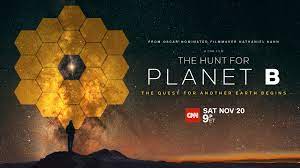 If you are among those intrigued with outer space, you might want to skip NCAA football for a couple of hours and tune in to CNN tonight at 9PM (EST) or 4PM in Hawaii. The Hunt for Planet B will be setting the stage for, finally, and hopefully, the launch of NASA's James Webb Space Telescope on December 18 at 7:20 (EST) on an Ariane 5 rocket at the European Spaceport located near Kourou, French Guiana. This is Europe's contribution to the project. Why here is that the location is at the equator.
If you are among those intrigued with outer space, you might want to skip NCAA football for a couple of hours and tune in to CNN tonight at 9PM (EST) or 4PM in Hawaii. The Hunt for Planet B will be setting the stage for, finally, and hopefully, the launch of NASA's James Webb Space Telescope on December 18 at 7:20 (EST) on an Ariane 5 rocket at the European Spaceport located near Kourou, French Guiana. This is Europe's contribution to the project. Why here is that the location is at the equator.
The staff of the European Space Agency (
ESA) and NASA, plus much of the world, will be holding their collective breaths until the first sign of success occurs in about
six months after launch. Why? Just
read these details to appreciate the complexity of the operation to take the telescope a million miles away to the second Lagrange (
L2) at the Earth-Sun balance point.
A first comparison can be made with the infra red
Herschel Space Observatory, which in 2009 was placed by ESA at the L2 point, but died in 2013. A second is that the Webb improves on the
Hubble, which was deployed in 1990, more than 30 years ago, and is expected to function for another 30 years. James is simply 100 times more powerful than Hub, and sees in the infrared much further back in time.

The Webb Space Telescope began development in 1996 for launching in 2007 for an estimated total cost of $0.5 billion. Fourteen years later the estimated cost now is $10 billion (factor of 20 increase in price). Nothing new, for the Hubble Telescope was first funded in the 1970's for intended launch in 1983. Beset with problems, it finally flew in 1990. In 1978 Congress approved this project for $36 million. In 1990 the cost was up to $1.5 billion. A factor of more than 400. Total cost for telescope and operations? $21 billion. So if you think your mass transit original price of $1 billion is now $25 billion, that is about par for the cost when it comes to this kind of investment.
Here is a graphic comparison of JWST and Hubble:
The Origins Space Telescope would perform astrometry and astrophysics in the mid- to far-infrared range using a telescope with an aperture of 9.1 m (concept 1) or 5.9 m (concept 2).[7][8] The telescope will require cryocooler systems to actively cool detectors at ∼50 mK and the telescope optics at ∼4 K.[7] It will attain sensitivities 100–1000 times greater than any previous far-infrared telescope.[7]

One thing I learned about astrophysicists is that they keep trying, and, somehow, keep succeeding in getting your tax dollars. How much are they asking for this time? Only $5 billion. Know what it will ultimately cost? A factor of 50 would not be outrageous, or $250 billion. However, in comparison, the lifetime cost of the F-35 Lightning II fighter jet is now at
$1.6 trillion, and you know it will be much higher. To do what? The last two dogfights involving U.S. aircrafts occurred almost a quarter century ago when a U.S. Navy pilot flying a Tomcat (
this is the one Tom Cruise piloted in Top Gun) shot down a Syrian fighter, and in 1999 when a
Navy Super Hornet used a missile to beat a Syrian Su-22 fighter.
The primary purpose of these telescopes is to find exo-Earths. Maybe because we might need to know where they are if we screw up our planet, or just the challenge to find extraterrestrial life.
The closest star to us is Proxima Centauri at a distance of 4.25 light years. There is no hope for life in the Alpha Centauri star system, anyway, but, say, a spaceship can be built and energized (
the energy cost would be beyond any capability we have today) to travel 35,000 MPH (
the speed of Voyager 1). It would take 73,000 years to get there. Remember, Jesus Christ was only around 2000 years ago. There is the
Toba Catastrophe Theory speculating that around that time in our history, Mount Toba erupted and almost ended all of human life.
But you say, surely we will someday find a faster way to travel, for how are flying saucers getting to us? Wormholes and the like have been mentioned, but space scientists are just about unanimously of the opinion that the odds of alien visits are so low as to be close to impossible.
- Electromagnetic Fields
- Magnet Explosions.
- Wave-Particle Interactions.
You can read the details if you wish, but if anything works, Star Trek-like travel to other galaxies are beyond reality. The closest galaxy to our Milky Way is Andromeda, and if you find a way to travel at just about the speed of light, it would take more than 2.5 million years to get there.
Homo sapiens, us, only evolved 0.3 million years ago.
On that basis, even the Search for Extraterrestrial Intelligence needs to forget about communication, and focus more on detection, hoping that some advanced civilization way out there thought it was worthwhile to send out something like
Encyclopedia Galactica, to help us tame fusion, attain global peace and the like. If there is life in our Universe elsewhere, some of these societies could well be billions of years more advanced than us.
-

















Comments
Post a Comment